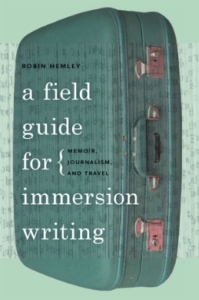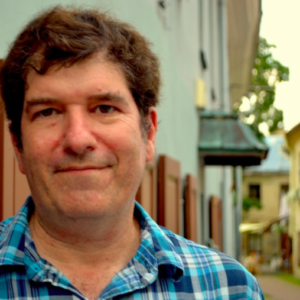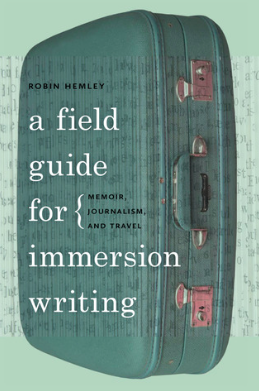Writers Read: A Field Guide for Immersion Writing by Robin Hemley
 A Field Guide for Immersion Writing is Robin Hemley’s non-fiction methodological primer for writers on immersion journalism. In this compilation, Mr. Hemley covers a gamut of approaches to tackling immersion-writing projects, using examples of his work and other writers’ works to apply the mechanics of the narrative process. His techniques cover advice for undertaking and refining such sub-genres as memoir, travel, investigative, and journalistic endeavors.
A Field Guide for Immersion Writing is Robin Hemley’s non-fiction methodological primer for writers on immersion journalism. In this compilation, Mr. Hemley covers a gamut of approaches to tackling immersion-writing projects, using examples of his work and other writers’ works to apply the mechanics of the narrative process. His techniques cover advice for undertaking and refining such sub-genres as memoir, travel, investigative, and journalistic endeavors.
Mr. Hemley writes about the subject and sub-genres of immersion writing, including one chapter on ethics and legalities, and his last chapter on practical “how-tos” for crafting a book or article proposal. Written in first person, the author acts as the narrator for his audience. At the beginning of each chapter, Hemley briefly introduces the specific genre or sub-genre he will be discussing and then breaks the chapter down into further section specifics.
Though the reader may not always agree with the author’s point of view, Mr. Hemley does a consistent job of keeping the subject matter interesting by providing a series of almost continuous anecdotal first-hand accounts of his own experiences.
Though the reader may not always agree with the author’s point of view, Mr. Hemley does a consistent job of keeping the subject matter interesting by providing a series of anecdotal first-hand accounts of his own experiences, as well as the experiences of fellow immersion writers both historical and contemporary. In laidback, engaging, sometimes-humorous language, the author illustrates his ideas and concepts in words that are clear and easy to understand. Chapters build upon previous chapters, sometimes overlapping in information and genre approach, but this repetition only serves to emphasize the information, rather than complicate it, and there is no reader overload.
At the end of each chapter there is a section entitled Exercises, which provide the reader with creative opportunities and prompts to implement what has been learned in the previous chapter.

Robin Hemley, author of A Field Guide for Immersion Writing
As a rule, this writer does not often like books that tell her how to write. Many times such narratives can leave a writer feeling “talked at,” and contain a majority of information that can be found during a thorough search on Google. For free. However, A Field Guide for Immersion Writing is one of the few exceptions to this rule. It is a must for every bookshelf.
From the beginning, readers will find themselves engaged by the deliberate way in which Mr. Hemley lays his knowledge and experience out for the writer in a step-by-step guide, outlining specificities and techniques that end up teaching even a seasoned writer how to build, or further a successful immersion writing career. Many of the author’s techniques are those of which experienced writers will recognize they already employ when crafting their stories; for them, Mr. Hemley offers validation and a refresher course. For writers, both beginning and seasoned who are interested in starting an immersion writing project and are needing a clearer map of the process involved, A Field Guild for Immersion Writing offers fresh and easy tools for implementation. The author’s conversational, non-confrontational style keeps the pages turning. Mr. Hemley’s exercise ideas at the end of each chapter, are both provocative and creative, and Mr. Hemley’s last chapter on crafting a proposal, something with which many writers, especially newcomers, need help, employs a made-easy, non-scary approach that is a relief for any writer.
Mr. Hemley’s concluding paragraph speak of his intentions in crafting this narrative:
I recently learned that the Japanese word sensei doesn’t mean “teacher” in the simple sense as I have long believed, but is better translated as “one who has gone before.” It’s in this spirit that I have written this book and used the examples I’ve threaded throughout—it helps to know that others have gone before. When I’m driving in a storm or at night and the visibility is low, I’m always grateful when up ahead I see a pair of taillights I can follow to keep me from drifting, to keep me on course of my destination, wherever that turns out to be (187).
For this writer, Mr. Hemley provided just that.


 Miriam González-Poe holds an MFA in Creative Non-fiction from Antioch University, Los Angeles. Her writings have appeared in The Round-up, Culture Shôk, Fine Linen, Inner Circle, and other publications. She is currently a staff writer for Drunk Monkeys and lives in Los Angeles with her family, where she spends her time balancing the demands of the real world with her personal harmonic convergence. She is also an award winning jewelry artist producing works under Mac Originals.
Miriam González-Poe holds an MFA in Creative Non-fiction from Antioch University, Los Angeles. Her writings have appeared in The Round-up, Culture Shôk, Fine Linen, Inner Circle, and other publications. She is currently a staff writer for Drunk Monkeys and lives in Los Angeles with her family, where she spends her time balancing the demands of the real world with her personal harmonic convergence. She is also an award winning jewelry artist producing works under Mac Originals.


